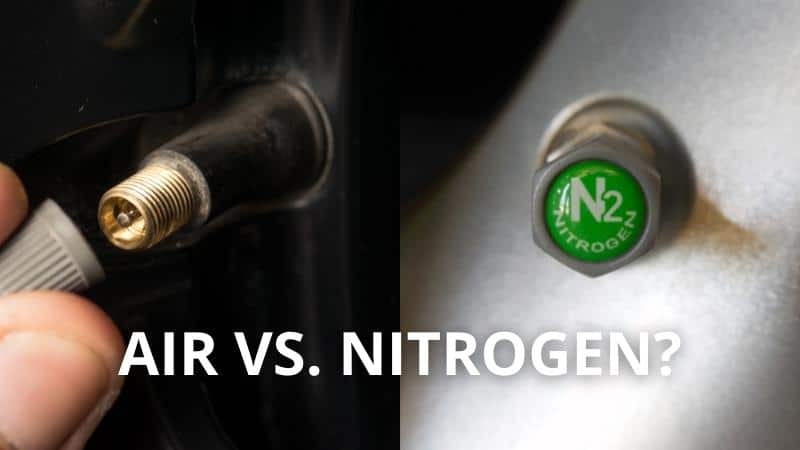Are you thinking of inflating your car tire?
Then, which is the best to use between Nitrogen and air?
This post will compare the two to help you make a wise decision.
What is Nitrogen?
Nitrogen forms 78% of the air, oxygen forms 21%, and gases such as argon and neon form 1%. Nitrogen is a dry, colorless and odorless gas. Also, it is non-reactive under normal conditions and non-flammable.
Most airplanes, race cars, and heavy equipment tires are inflated with Nitrogen. Since these vehicles expose their tires to extreme temperature circumstances, using Nitrogen offers smooth control over tire pressure when tire temperatures increase.
Using dry Nitrogen reduces the effects of moisture, and the tire pressure increase due to temperature is more predictable than air.
Why Use Nitrogen Instead of Air in Tires?
Small amounts of air may leak out of the tire within a given duration, mainly if the tires are subjected to extreme temperature conditions.
This happens because tire walls are slightly porous. Therefore, when it becomes hot, the air expands. This increases pressure which pushes small amounts of air out through the pores; hence you will be required to top up your air even when your tire has no puncture.
Compared to normal air molecules, Nitrogen molecules are larger, making them hard to leak out. This allows a Nitrogen-filled tire to retain air pressure for a longer duration compared to air-filled tires, leading to longer tire life and better fuel economy.
Is Nitrogen Better Than Air in Tires?
According to a National Highway Traffic Safety Administration (NHTSA) study, it was found that normal air penetrates through the tires at a higher rate compared to pure Nitrogen. Therefore, the conclusion is that using Nitrogen reduces tire degradation by preventing oxidation. So, it’s better in that sense, however more pricey.
The Pros of Using Nitrogen to Fill Tires
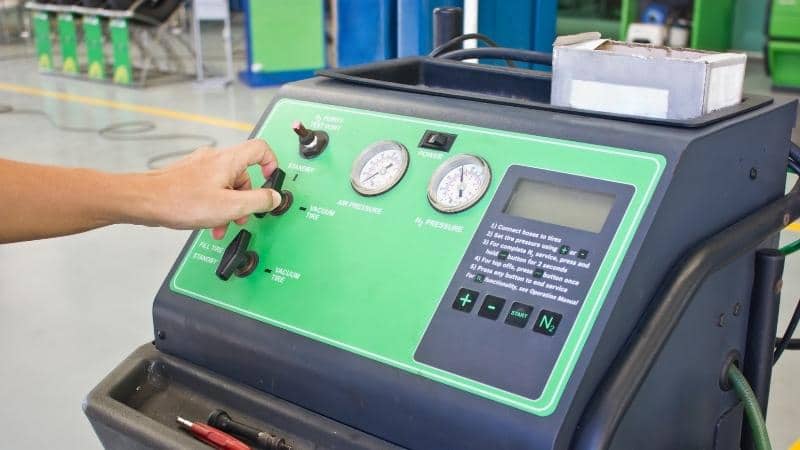
1. Durability
Durability is the most significant advantage in anything you may wish to acquire. Nitrogen tires are more durable since they do not rust as air-filled tires has a tendancy to do. Drivers prefer filling their car tires with Nitrogen to reduce tear and wear on the tires and other car parts.
2. Stable Tire Pressure
Since Nitrogen hardly penetrates through the tire rubber, Nitrogen filled tires remain strong for a long time. Also, underinflated tires indicate minor pressure variation with a temperature change.
3. Fuel-Efficiency
The constant tire pressure dramatically improves fuel efficiency hence saving some money. This happens only with Nitrogen inflated tires, which is very helpful for drivers. To be precise, higher tire pressure reduces friction as the car rolls and decreases inflation.
4. Less or no Leakage from Tires
As we talk about the pros of Nitrogen in tires, we consider the rate at which air escapes from the tires. The tire rubber stretches and flexes while rolling as the vehicle moves, slowly deflating the tire.
A Nitrogen atom is bigger than an Oxygen atom from a chemistry perspective. Therefore, Nitrogen may not as easily escape from a permeate rubber or tire.
5. Eco-friendly
In each year, more than 300 million tires are disposed of, using Nitrogen inflated tires can reduce this number by 30%.
Specifically, tires inflated with Nitrogen have prolonged life hence reducing the demand of car owners. Not to mention, they reduce fuel combustion, therefore, lowering carbon footprint.
The Cons of Using Nitrogen to Fill Tires
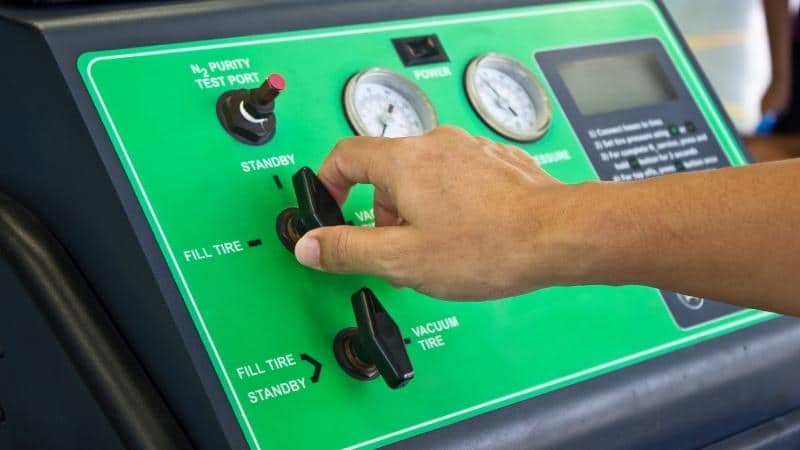
1. Unavailability
It is not easy to find a place where you can inflate your tire with Nitrogen. To be more specific, you cannot find such service everywhere as it is only found at a particular tire shop or professional service station.
In many cases, you will have to fill your tires using the normal air since a nitrogen service station may not be available at your place. So, this will dilute the Nitrogen in your tires.
2. Costly
Nitrogen is expensive, that is the fact. Due to that reason, inflating the tire with Nitrogen is more costly as compared to normal air inflation.
You may be required to pay about $5 for inflating one tire with Nitrogen, not to mention the time the attendant would take to operate.
3. Time Consuming
Filling Nitrogen in a tire is not a walk in the park. Car owners require skills to perform nitrogen fill-up because it is complicated. In order to get the best out of filling your tire with Nitrogen, you should blend and fill the tires several times to have as much air as possible.
If your tire shop has a filter machine that can get rid of oxygen from Nitrogen, it can be a great help to speed up the process, although it is expensive.
4. Maintenance is still required
Inflating your tire with Nitrogen does not mean that it is a one-time event. Therefore, maintaining your tire is an important activity that should be done regularly and checking the pressure. Failing to do so may result in uneven tire wear and loss of gas mileage.
The Pros of Using Air to Fill Tires
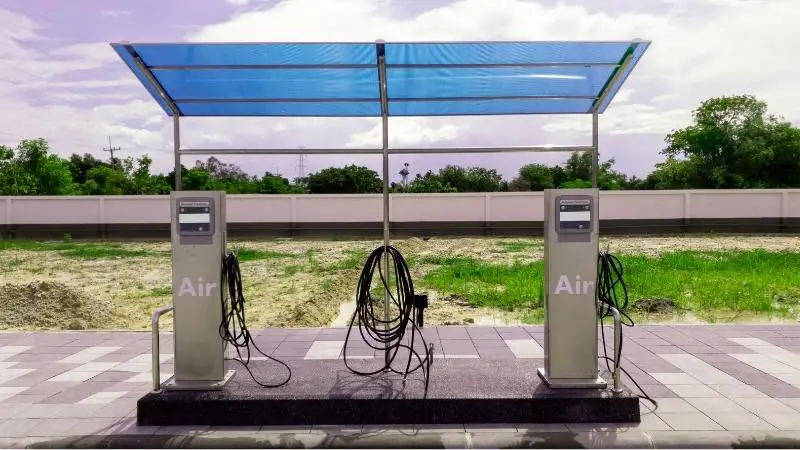
1. It’s cheap
Inflating your tire using air is free of charge. Just visit any tire dealer or service station anywhere, and you will have your tire filled up or regulate your tire pressure for free.
That is not the case with Nitrogen. Nitrogen infrastructure is not fully developed hence expensive in few places found.
2. Available almost everywhere
Free things are not found everywhere, but that is different from normal air. Normal air is available in all fuel stations where you can have your tire pressure checked or filled if it is less.
The Cons of Using Air to Fill Tires
1. Wears out a tire faster
Tires filled with normal air wear out at a higher rate than Nitrogen. Normal air has some moisture that may wet the inside of the tire, whether tubed or tubeless.
Therefore, the tire corrodes, leading to a higher rate of wear. Also, the friction between the tire and the surface increases during hot seasons.
2. High rate of leakage
Since oxygen molecules are smaller than Nitrogen, tires that are filled up with oxygen, and their pressure decreases at a higher rate. That is why you should check your tire pressure on a weekly basis.
Can You Mix Nitrogen and Air in Tires?
In some cases, you may inflate your tire with Nitrogen and find that your tire is low when having a long road trip. You can’t find Nitrogen anywhere in the nearby service stations. Should you keep on driving on a low tire pressure or top it off?
Driving on an under-inflated tire is never a wise idea. Mixing compressed air with Nitrogen won’t cause any serious threat to your tire. It will only dilute the Nitrogen and reduce its effectiveness.
How to Fill Nitrogen in Tires
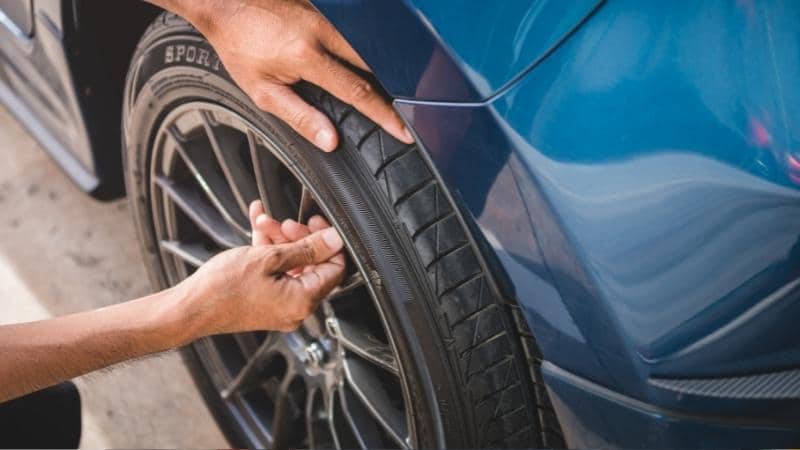
If it’s your first time filling your tires with Nitrogen, don’t worry. The steps we have highlighted below are easy to follow and will help you fill your tires up with Nitrogen correctly.
Step 1: Remove the hubcap covering the tire valve stem. If you are not sure, check your car manual. Although, some vehicles may not have hubcaps.
Step 2: Identify the valve stem. Nitrogen-filled tires come in a bright green or different colored valve stem to distinguish them from normal tires. Check if the valve stem is damaged or is leaking. If yes, have your valve stem replaced.
Step 3: Pull out the cap of the valve stem. Do not shake or twist to avoid rupture or racking the valve stem.
Step 4: Confirm the tire psi ratings and place the pressure gauge on the valve. If the pressure gauge readings are within the recommended psi, do not add air to the tire. You can replace the valve stem cap.
Step 5: Switch on the Nitrogen air compressor. Be sure the connection to the air compressor is designed for such a valve. Place the air compressor on the valve stem and press down. Do not force the air compressor connection down the valve to avoid destroying the valve stem.
Step 6: Hold the air compressor connection on the valve stem for about 10 seconds. Confirm the psi again. Continue filling the tire for intervals of 10 seconds until the desired pressure is attained. When the recommended range is achieved, switch off the air compressor and replace the valve stem and the hubcap.
Where Can You Fill up Your Tires With Nitrogen?
1. Car Dealerships
New cars come with Nitrogen- filled tires. After purchasing the vehicle, you can have your tires filled with Nitrogen by the dealer for free.
Additionally, the dealership also fills any new tire bought from them with Nitrogen free of charge. Used car dealers also fill tires with Nitrogen at a fee or free of charge.
2. Discount Superstores
Most discount superstores with car centers have nitrogen tire filling stations. Also, they sell new tires and fill or refill them with Nitrogen for free or at a fee.
3. Tire Centers
All tire centers have nitrogen tire filling points. They can top off a used tire brought to them or sell a new one and fill it. However, they charge a small fee to fill a tire.
How Much Does it Cost to Fill a Tire With Nitrogen?
If you want to fill new tire with Nitrogen, you will spend anywhere between $70 and $180. If you want to top off existing tires, expect to pay about $30 per tire. This is because used tires need to have their oxygen purged with several nitrogen refills. If the existing tires have Nitrogen, refilling may cost anywhere from $5 to $7 per tire.
How Often Do You Need to Refill Nitrogen Tires?
Nitrogen-filled tires require weekly checks and should be filled at least once every 2-3 months. This is because Nitrogen filled tires lose about 60% less pressure than a normal air-filled tire.
The variation in molecule sizes brings about the difference. Nitrogen has large molecules making it hard to leak out, while normal air has small molecules that leak out easily.
How Can You Tell if Your Tires are Filled With Nitrogen or Air?
Nitrogen-filled tires have green valve caps written Nitrogen or N2. If it’s the first time your tires are filled with Nitrogen, the tire center, dealership, or discount store will remove the existing valve caps and provide green ones. These green valve caps protect car owners from placing normal air inside the tire.
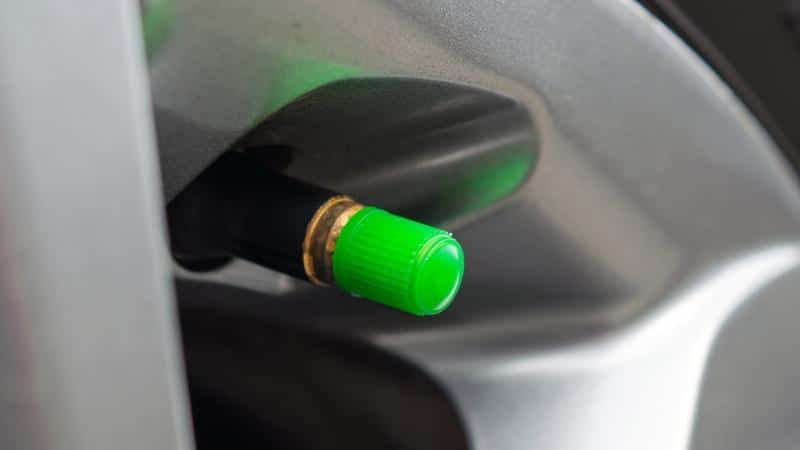
How do Nitrogen Filled Tires Handle Cold and Hot Weather?
Under normal conditions, temperature variations cause an effect on both living and non-living things. Therefore, car tires are not an exception. So, when the temperature changes, the pressure in Nitrogen filled tires also changes.
For instance, a temperature change of about 10 F degrees will cause a 1.9% change in pressure. If the tire is 32 psi full at 75 F and the temperature drops by 10 F, the tire pressure will drop to 31.4 psi. This is a difference of 0.6 psi.
These variations will occur as the temperature drops and rises, whether the inflation gas is Nitrogen or normal air. Luckily, tire manufacturers understand these effects and design their tires with recommended inflation pressure.
Nevertheless, Nitrogen does not have contaminants found in normal air. Thus, as you drive and your vehicle tires heat up, air-filled tires will fluctuate more in temperature than Nitrogen filled tires.
Do Nitrogen-Filled Tires Run Cooler Than Air-Filled Tires?
Yes. As said earlier in this post, Nitrogen-filled tires will make them run cooler compared to if they were filled with air.
Since nitrogen particles do not easily penetrate the tire walls, this improves stability. This improved stability will make the tire bend and twitch less, which reduces the build up of heat.
Additionally, tires filled with Nitrogen will not heat up as easily as air-filled tires. This feature allows you to reduce the risk of blowouts and other tire problems.
Why do Race Cars Use Nitrogen in Tires?
Experienced car racers purport that Nitrogen filled tires react less to temperature fluctuations than normal air-filled tires.
When heated, gas will expand, and when cooled, gas will contract. This is why the tire pressure warning light comes on as temperatures fall. For racing cars, filling the tires with Nitrogen will provide more consistent inflation pressures while racing as the tires heat up. Therefore, race cars always use Nitrogen in their tires.
Final Words
It does not matter if you have your tire inflated with Nitrogen or air, but regular checks and maintenance are essential and necessary. Using Nitrogen alone does not mean you should not maintain your pressure inflation.
Therefore, keep your tire pressure at the recommended rate. Overinflation or underinflation may create excessive stress or heat build-up, leading to tire disablement or detachment by a tread belt. This may cause accidents.
Every morning before starting your car, spare some minutes to check your tire pressures. Also, ensure that you have a spare wheel in good condition. This will save you from headaches down the road and your money too.
Hi, my name is Niklas, the head content creator & CEO of Whirling Wheelz. I am very interested in vehicles of all kinds, mainly cars. I have a car mechanics degree from high school and a big hobby of mine is to follow the WRC (World Rally Championship) both online and through travel.

